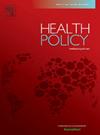Understanding the impact of minimum staff level policies on the ward nursing team: Insights from a qualitative research study conducted in Germany
IF 3.6
3区 医学
Q1 HEALTH CARE SCIENCES & SERVICES
引用次数: 0
Abstract
Background
The implementation of legally mandated staffing levels for nurses has complex and wide-ranging effects on the organizational environment in which they operate.
Objective
The aim of this study was to investigate the perspectives of nursing staff on these consequences.
Methods
Nine guideline-based expert interviews were conducted with nursing staff at a hospital unit in Germany where minimum nurse-to-patient ratios have been mandated since 2017. The analysis was carried out according to the summarizing qualitative content analysis with the help of the inductive category formation according to Mayring (2015).
Results
The participants confirmed the intended effects, e.g. the gain in time for care, but also mentioned that strict nurse-to-patient ratio guidelines for different patient types may lack practical relevance. Furthermore, the staff policy had several unintended side-effects on the nursing team: Nurses reported the formation of subgroups within the team, and that new challenges had arisen due to the wider range of personal characteristics, qualifications and experience levels on the team.
Conclusions
Although the positive effects on patient care reflect the importance of minimum staff policies, the negative repercussions on the nursing team ward and its daily work processes need to be taken into account and actively managed.
了解最低员工水平政策对病房护理团队的影响:来自德国进行的定性研究的见解
实施法律规定的护士人员配备水平对其所在的组织环境具有复杂而广泛的影响。目的探讨护理人员对这些后果的看法。方法对德国一家医院的护理人员进行了9次基于指南的专家访谈,该医院自2017年以来一直强制要求最低护士与患者比例。分析是在总结定性内容分析的基础上,借助Mayring(2015)的归纳分类形成进行的。结果参与者确认了预期的效果,例如护理时间的增加,但也提到严格的护士与病人比例指南可能缺乏实际的相关性。此外,员工政策对护理团队产生了一些意想不到的副作用:护士报告说,团队内部形成了小组,由于团队中个人特征、资格和经验水平的差异更大,新的挑战也出现了。结论虽然对病人护理的积极影响反映了最少人员政策的重要性,但对护理团队病房及其日常工作流程的负面影响需要考虑并积极管理。
本文章由计算机程序翻译,如有差异,请以英文原文为准。
求助全文
约1分钟内获得全文
求助全文
来源期刊

Health Policy
医学-卫生保健
CiteScore
6.40
自引率
6.10%
发文量
157
审稿时长
3-8 weeks
期刊介绍:
Health Policy is intended to be a vehicle for the exploration and discussion of health policy and health system issues and is aimed in particular at enhancing communication between health policy and system researchers, legislators, decision-makers and professionals concerned with developing, implementing, and analysing health policy, health systems and health care reforms, primarily in high-income countries outside the U.S.A.
 求助内容:
求助内容: 应助结果提醒方式:
应助结果提醒方式:


